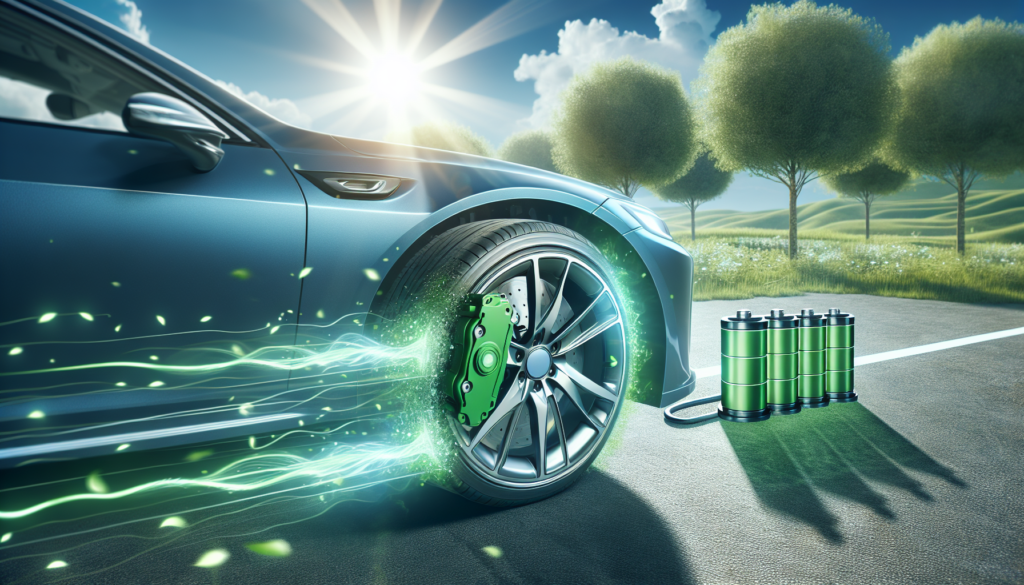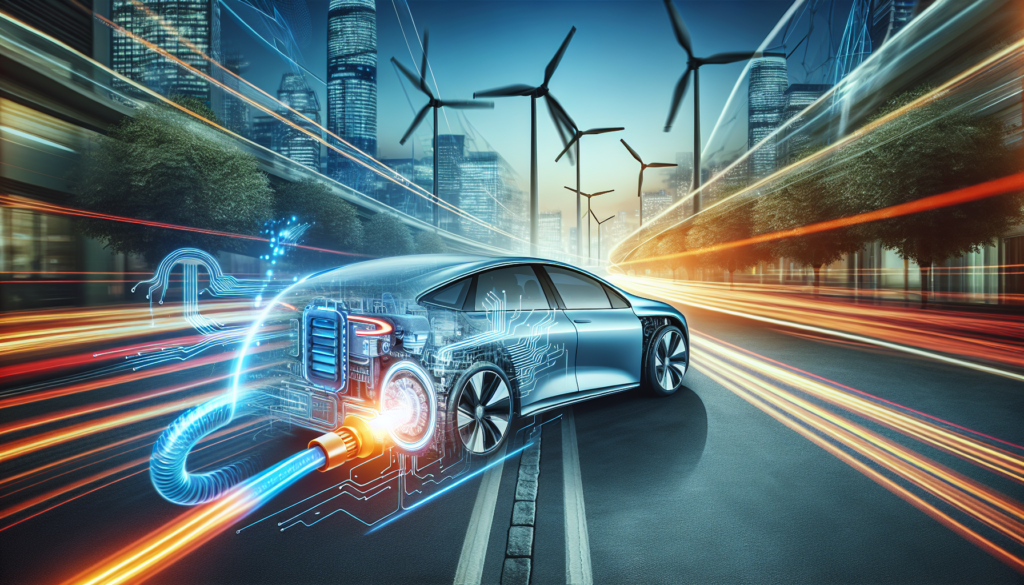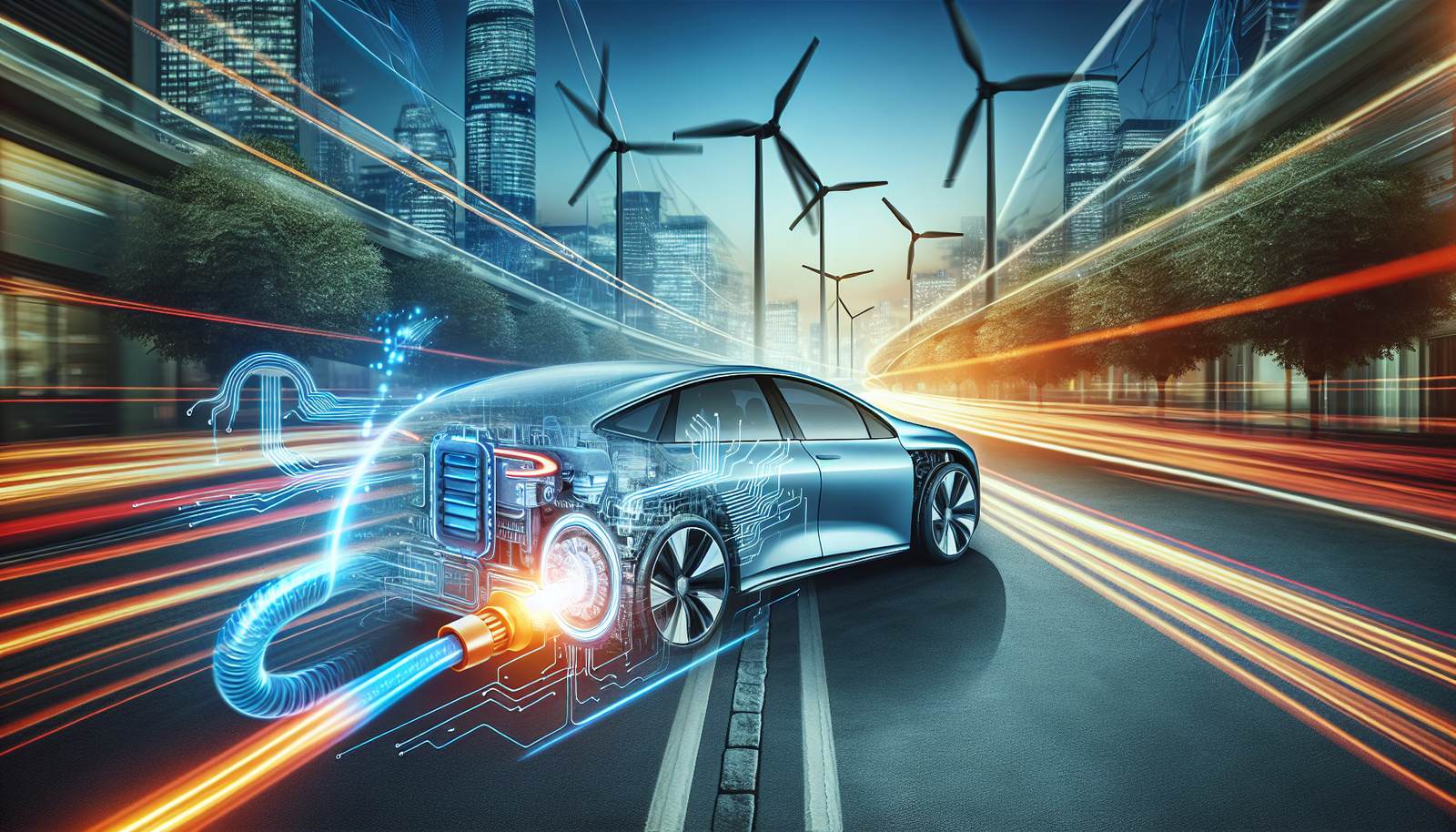Imagine a future where every time you hit the brakes in your car, instead of wasting that energy as heat, it is captured and used to power your vehicle. This is the promise of regenerative braking technology, a groundbreaking innovation that is revolutionizing the way we think about energy efficiency. No longer are brakes simply a means to slow down or stop, they now have the potential to generate and store energy, making cars more fuel efficient and environmentally friendly. In this article, we will explore the fascinating world of regenerative braking technology and how it is transforming the automotive industry. Embrace the future of transportation and discover how this innovative technology is paving the way towards a more sustainable future.
Introduction
Regenerative braking is an innovative technology that has gained momentum in recent years, revolutionizing the way we think about energy efficiency in transportation. By harnessing the power of kinetic energy, regenerative braking systems have the potential to significantly reduce fuel consumption, extend battery life, decrease emissions, and enhance vehicle control and safety. In this article, we will delve into the working principle of regenerative braking, explore its benefits, discuss its applications and adoption across various industries, examine the challenges and limitations it faces, highlight technological advances in the field, showcase real-world case studies, and discuss the future developments and potential impact of this groundbreaking technology. Let’s embark on a journey to discover how regenerative braking is contributing to a more sustainable and energy-efficient transportation system.
Explanation of regenerative braking
Regenerative braking is a technique that allows vehicles to recover and store the energy generated during braking. In traditional braking systems, the kinetic energy produced when a vehicle decelerates or comes to a stop is dissipated as heat through the friction between the brake pads and the rotors. This wasted energy not only leads to decreased fuel efficiency but also contributes to increased wear and tear on the brakes. In contrast, regenerative braking systems utilize electric motors or generators to convert the kinetic energy of the moving vehicle into electrical energy, which can be stored in batteries or used to power other electrical systems within the vehicle.
Importance of energy efficiency
Energy efficiency is a crucial aspect of sustainable transportation. With the increasing demand for mobility and concerns over climate change and finite fossil fuel resources, finding ways to optimize energy usage has become more pressing than ever. Energy-efficient technologies like regenerative braking can make a significant difference in reducing greenhouse gas emissions, conserving natural resources, and improving overall operational and economic efficiency in transportation.
Overview of regenerative braking technology
Regenerative braking technology has seen remarkable advancements in recent years, thanks to rapid progress in electric and hybrid vehicle technologies. While regenerative braking was initially developed for electric trains and trams, it has now been integrated into various modes of transportation, including automobiles, public transportation systems, and even industrial machinery. This technology has gained popularity due to its multiple benefits and potential for widespread adoption. Now, let’s dive into the working principle of regenerative braking and understand how it translates into improved energy efficiency.
Working Principle of Regenerative Braking
Traditional braking systems
Before we discuss regenerative braking, it’s essential to understand how traditional braking systems operate. In conventional systems, when the driver applies the brakes, hydraulic fluid is used to transmit the force from the pedal to the brake calipers, which press the brake pads against the rotors, creating friction that slows down the vehicle. Unfortunately, this process dissipates the generated kinetic energy as heat, resulting in energy wastage and reduced overall efficiency.
Introduction to regenerative braking
Regenerative braking builds upon the principles of traditional braking systems but introduces a new level of efficiency and energy recapture. In vehicles equipped with regenerative braking systems, the kinetic energy generated during braking is converted into electrical energy and stored for later use, rather than being wasted as heat. This electrical energy can be utilized to power the vehicle’s electrical systems, such as lights, air conditioning, or even recharging the batteries in electric or hybrid vehicles.
How regenerative braking works
Regenerative braking works by utilizing electric motors or generators to transform kinetic energy into electrical energy. When the driver applies the brakes, instead of dissipating the energy as heat, the electric motor or generator switches into generating mode and acts as a generator, converting the rotational energy of the wheels into electrical energy. This electrical energy is then either stored in batteries or immediately used to power various electrical systems within the vehicle. This process allows for energy recapture, reduces the reliance on the conventional braking system, and improves overall energy efficiency.
Conversion of kinetic energy to electrical energy
The process of converting kinetic energy to electrical energy involves multiple components working together seamlessly. As the driver applies the brakes, the regenerative braking system engages, and the electric motor or generator starts to rotate. The rotation of the wheels and the connected components results in the generation of electricity. The generated electricity flows through a power inverter, which converts the direct current (DC) produced by the generator into alternating current (AC) suitable for charging batteries or powering other electrical systems. The electrical energy is then stored in high-capacity batteries, ready to be utilized when needed. This conversion process allows for the efficient recapture of energy that would otherwise have been wasted.

Benefits of Regenerative Braking
Improved energy efficiency
One of the primary benefits of regenerative braking is the improved overall energy efficiency in vehicles. By capturing and utilizing the kinetic energy that would have otherwise been wasted as heat, regenerative braking systems can significantly reduce energy consumption. This increased energy efficiency translates into longer driving ranges, reduced dependence on fossil fuels, and substantial cost savings.
Reduced fuel consumption
Regenerative braking systems have a profound impact on reducing fuel consumption, particularly in hybrid vehicles. By recapturing and reusing the energy generated during braking, these systems relieve the burden on the traditional internal combustion engine, leading to less fuel usage. This fuel-saving capability not only contributes to cost savings but also helps in reducing greenhouse gas emissions and combating climate change.
Extended battery life
In electric and hybrid vehicles, regenerative braking plays a crucial role in maximizing the battery life. By harnessing the kinetic energy during deceleration and braking, these systems replenish the energy stored in the batteries, minimizing the reliance on external charging sources. This process reduces the number of times the battery needs to be charged, thus extending its lifespan and ensuring optimal battery performance over time.
Decreased emission of pollutants
Regenerative braking systems make a significant contribution to reducing the emission of pollutants, particularly in urban areas where congestion and stop-and-go traffic are prevalent. By utilizing regenerative braking, vehicles produce less greenhouse gas emissions and particulate matter, leading to improved air quality and reduced environmental impact. This benefit is especially pronounced in electric and hybrid vehicles, where regenerative braking significantly reduces tailpipe emissions.
Enhanced vehicle control and safety
Beyond the energy efficiency and environmental benefits, regenerative braking also enhances vehicle control and safety. The ability to capture and control the braking force precisely allows for smoother deceleration and improved traction control. This advanced level of braking precision reduces the risk of wheel lock-up, minimizes the chance of skidding or sliding, and improves overall vehicle stability. Enhanced vehicle control translates into safer driving experiences and greater confidence, both for the driver and other road users.
Applications and Adoption
Automotive industry
The automotive industry has been quick to recognize the advantages of regenerative braking and has adopted this technology extensively. From electric vehicles to hybrid cars, regenerative braking has become a staple feature in many modern vehicles. Major automakers, including Tesla, Toyota, and Volvo, have integrated regenerative braking systems into their vehicle models, offering drivers enhanced energy efficiency and improved driving experiences.
Public transportation
Regenerative braking technology has found significant applications in public transportation systems, such as buses and trains. The stop-and-go nature of urban bus routes and the frequent braking required in train systems make them ideal candidates for regenerative braking. By implementing regenerative braking in buses and trains, transportation authorities can achieve substantial cost savings, reduce greenhouse gas emissions, and enhance passenger comfort and safety.
Electric and hybrid vehicles
Regenerative braking plays a pivotal role in electric and hybrid vehicles, where energy efficiency and range anxiety are critical considerations. These vehicles rely on high-capacity batteries to power their electric motors, and regenerative braking helps replenish the energy stored in the batteries, minimizing the need for frequent recharging. The integration of regenerative braking in electric and hybrid vehicles has significantly contributed to improving their operation range, battery life, and overall energy efficiency, making them more viable and appealing to a wider consumer base.
Industrial machinery and equipment
Regenerative braking technology has also found applications beyond the automotive sector. In industrial machinery and equipment, such as cranes, forklifts, and mining haul trucks, regenerative braking provides multiple benefits. By harnessing the kinetic energy produced during deceleration, regenerative braking helps reduce energy consumption and operational costs, enhance equipment safety and control, and even contribute to the stability of the power grid through energy recapture and reuse.

Challenges and Limitations
High initial cost
One of the primary challenges facing the widespread adoption of regenerative braking systems is the high initial cost involved in implementing this technology. The integration of regenerative braking requires significant modifications to the vehicle’s braking system, including the addition of electric motors or generators, power inverters, and high-capacity batteries. These components, along with the necessary control systems, can increase the overall cost of the vehicle. However, as technology advances and economies of scale come into play, the cost of regenerative braking systems is expected to decrease, making them more accessible to a broader range of consumers and industries.
Compatibility with existing infrastructure
Another challenge is the compatibility of regenerative braking systems with existing infrastructure. Due to the unique electrical power requirements, regenerative braking may necessitate updates to charging infrastructure, power distribution systems, and electrical grids. Adapting existing infrastructure to accommodate regenerative braking technology can be costly and time-consuming. However, as the adoption of electric and hybrid vehicles increases, the necessary infrastructure updates are likely to become more commonplace, further incentivizing the implementation of regenerative braking systems.
Range limitations for electric vehicles
While regenerative braking significantly extends the driving range of electric vehicles, these vehicles still face range limitations compared to traditional internal combustion engine vehicles. The limited energy storage capacity of current battery technologies restricts the distance electric vehicles can travel before requiring a recharge. While regenerative braking mitigates some of these limitations, advancements in energy storage technologies and infrastructure are necessary to fully overcome the range anxiety associated with electric vehicles.
Performance in extreme weather conditions
Regenerative braking systems may experience performance limitations in extreme weather conditions. Cold temperatures can affect battery performance, reducing the amount of energy that can be recaptured and stored. In addition, slippery road conditions during snow or ice can affect traction and braking performance, making it challenging for regenerative braking systems to operate optimally. Ongoing research and development in the field aim to improve the performance of regenerative braking systems in extreme weather conditions, ensuring their reliability and effectiveness regardless of the surroundings.
Technological Advances
Improved energy storage systems
Advancements in energy storage systems hold great promise for the future of regenerative braking technology. The development of high-capacity, lightweight batteries with improved energy density and faster charging capabilities can significantly enhance the effectiveness of regenerative braking. Additionally, the integration of emerging technologies, such as supercapacitors or advanced flywheel systems, may further improve energy storage efficiency, allowing for greater energy recapture and utilization.
Optimized regenerative braking algorithms
The optimization of regenerative braking algorithms plays a crucial role in maximizing energy recapture and improving overall vehicle performance. By fine-tuning the control systems and algorithms that govern regenerative braking, engineers can ensure that energy is efficiently captured during braking events and intelligently distributed throughout the vehicle’s electrical systems. Advances in artificial intelligence and machine learning can greatly contribute to optimizing these algorithms, enabling even greater energy efficiency and precision.
Integration of regenerative braking with other technologies
Regenerative braking technology can be further enhanced through integration with other complementary technologies. For example, combining regenerative braking with solar panels, wind turbines, or even kinetic energy recovery systems can expand the sources of energy recapture and utilization, significantly boosting overall energy efficiency. The seamless integration of regenerative braking with other innovative technologies can pave the way for a truly sustainable transportation ecosystem.
Advancements in motor and generator systems
The continuous advancements in motor and generator systems are instrumental in improving the performance of regenerative braking technology. Higher efficiency electric motors, with reduced weight and smaller physical footprints, enable more precise control and higher energy recapture. Similarly, the development of advanced generator systems capable of generating electricity in a wide range of conditions ensures that regenerative braking remains reliable and effective across different vehicle types and operating conditions.
Case Studies
Tesla’s regenerative braking system
Tesla Motors, a leading name in electric vehicles, has pioneered the development and implementation of regenerative braking technology in their vehicle lineup. Tesla’s regenerative braking system allows for significant energy recapture, contributing to extended driving range and improved overall efficiency. This system has become a hallmark feature of Tesla vehicles, showcasing the benefits and potential of regenerative braking in enhancing energy efficiency and driving performance.
Toyota’s Hybrid Synergy Drive
Toyota, a frontrunner in hybrid vehicle technology, has successfully incorporated regenerative braking into their Hybrid Synergy Drive system. This innovative system captures and stores the kinetic energy generated during braking, utilizing it to recharge the vehicle’s battery pack. By leveraging regenerative braking, Toyota hybrids achieve improved fuel efficiency, reduced emissions, and seamless transitions between the traditional internal combustion engine and the electric motor.
Volvo’s use of regenerative braking in buses
Volvo, a leading manufacturer of buses, has implemented regenerative braking systems in their vehicles to improve energy efficiency and reduce environmental impact. With their Electric Hybrid buses, Volvo utilizes regenerative braking to recover energy during deceleration and braking, leading to reduced fuel consumption and lower emissions. This integration of regenerative braking technology showcases how public transportation systems can benefit from this energy-saving innovation.
Efficiency gains in heavy-duty vehicles
Regenerative braking has also shown promise in heavy-duty vehicles, such as trucks and mining haulers. By recapturing and reusing the energy produced during braking, these vehicles have witnessed noticeable efficiency gains. Not only does regenerative braking reduce fuel consumption, but it also contributes to improved operational efficiency, increased productivity, and reduced downtime. These benefits make regenerative braking an enticing prospect for industries reliant on heavy-duty vehicles.
Future Developments
Integration with autonomous driving
The integration of regenerative braking with autonomous driving technology holds great potential for further enhancing energy efficiency and safety. Autonomous vehicles, equipped with advanced sensors and artificial intelligence, can optimize regenerative braking algorithms based on real-time traffic conditions, vehicle dynamics, and driver behavior. This integration enables vehicles to seamlessly adapt their braking patterns, ensuring maximum energy recapture and efficient utilization throughout the journey.
Next-generation regenerative braking systems
Continuous research and development in regenerative braking technology are paving the way for next-generation systems with even greater energy recapture capabilities. From enhanced electric motor designs to advanced battery technologies and optimized control algorithms, these upcoming regenerative braking systems aim to further improve energy efficiency and reduce reliance on traditional braking systems. The evolution of regenerative braking will continue to drive the shift towards sustainable transportation.
Advancements in energy recapture
In addition to improvements in regenerative braking, advancements in energy recapture technologies may further enhance overall efficiency. Potential innovations, such as piezoelectric materials or vibration-capturing systems, can capture and convert additional forms of energy, such as road vibrations or ambient vibrations, into electrical energy. These developments broaden the scope of energy recapture, making regenerative braking an even more powerful tool in the quest for sustainable transportation.
Widespread adoption in transportation
As regenerative braking technology becomes more widely recognized and integrated into various transportation sectors, its potential impact on energy efficiency and sustainability will continue to grow. With the increasing adoption of electric and hybrid vehicles, coupled with advancements in infrastructure and supportive policies, regenerative braking systems are poised to become standard features across different modes of transportation. The widespread adoption of regenerative braking represents a significant step towards achieving a greener and more energy-efficient future.
Conclusion
Regenerative braking technology is a game-changer in the pursuit of energy efficiency and sustainable transportation. By harnessing and converting kinetic energy into electrical energy, regenerative braking systems enhance overall energy efficiency, reduce fuel consumption, extend battery life, decrease emissions, and improve vehicle control and safety. Its applications span across the automotive industry, public transportation systems, electric and hybrid vehicles, and even industrial machinery. While challenges concerning high initial costs, infrastructure compatibility, range limitations, and extreme weather conditions exist, ongoing technological advances and research aim to overcome these barriers. Real-world case studies from companies like Tesla, Toyota, and Volvo demonstrate the practicality and effectiveness of regenerative braking. Looking ahead, the integration of regenerative braking with autonomous driving, the development of next-generation systems, advancements in energy recapture, and widespread adoption in transportation hold great promise. Continued investment in research and development is crucial to further optimize regenerative braking technology and realize its full potential in achieving a sustainable and energy-efficient transportation system. By embracing regenerative braking and its many benefits, we can pave the way to a greener, cleaner, and more efficient future.

